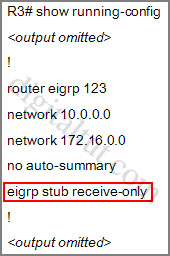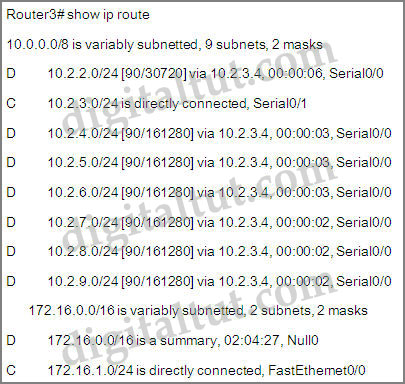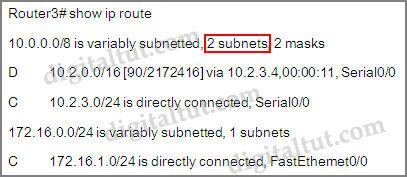 Presently JS has configured EIGRP on all routers in the network R2, R3, and R4. Your duty is to find and solve the connectivity failure problem with the remote office router R3. You should then configure route summarization only to the distant office router R3 to complete the task after the problem has been solved.
Presently JS has configured EIGRP on all routers in the network R2, R3, and R4. Your duty is to find and solve the connectivity failure problem with the remote office router R3. You should then configure route summarization only to the distant office router R3 to complete the task after the problem has been solved.The success of pings from R4 to the R3 LAN interface proves that the fault has been corrected and the R3 IP routing table only contains two 10.0.0.0 subnets.
First we have to figure out why R3 and R4 can not communicate with each other. Use the show running-config command on router R3

Notice that R3 is configured as a stub receive-only router. The receive-only keyword will restrict the router from sharing any of its routes with any other router in that EIGRP autonomous system. This keyword will also prevent any type of route from being sent.
Therefore we will remove this command and replace it with the eigrp stub command:
R3#configure terminal
R3(config)#router eigrp 123
R3(config-router)#no eigrp stub receive-only
R3(config-router)#eigrp stub
R3(config-router)#end
Now R3 will send updates containing its connected and summary routes to other routers. Notice that the eigrp stub command equals to the eigrp stub connected summary because the connected and summary options are enabled by default.
Next we will configure router R3 so that it has only 2 subnets of 10.0.0.0 network. Use the show ip route command on R3 to view its routing table
R3#show ip route

Because we want the routing table of R3 only have 2 subnets so we have to summary sub-networks at the interface which is connected with R3, the s0/0 interface of R4.
There is one interesting thing about the output of the show ip route shown above: the 10.2.3.0/24, which is a directly connected network of R3. We can’t get rid of it in the routing table no matter what technique we use to summary the networks. Therefore, to make the routing table of R3 has only 2 subnets we have to summary other subnets into one subnet.
In the output if we don’t see the summary line (like 10.0.0.0/8 is a summary…) then we should use the command ip summary-address eigrp 123 10.2.0.0 255.255.0.0 so that all the ping can work well.
In conclusion, we will use the ip summary-address eigrp 123 10.2.0.0 255.255.0.0 at the interface s0/0 of R4 to summary.
R4>enable
R4#configure terminal
R4(config)#interface s0/0
R4(config-if)#ip summary-address eigrp 123 10.2.0.0 255.255.0.0
Now we jump back to R3 and use the show ip route command to verify the effect, the output is shown below:

(But please notice that the ip addresses and the subnet masks in your real exam might be different so you might use different ones to solve this question)
But in your real exam, if you see the line “10.0.0.0/8 is a summary,….Null0″ then you need to summary using the network 10.0.0.0/8 with the command “ip summary-address eigrp 123 10.0.0.0 255.0.0.0″ . This configuration is less optimize than the first but it summaries into 2 subnets as the question requires (maybe you will not see this case, don’t worry!).
The command “copy running-config startup-config” will not work so try using this command; just skip if it doesn’t work.
Using GNS3 to simmulate this lab belows:
R3#show ip route
Codes: C - connected, S - static, I - IGRP, R - RIP, M - mobile, B - BGP
D - EIGRP, EX - EIGRP external, O - OSPF, IA - OSPF inter area
N1 - OSPF NSSA external type 1, N2 - OSPF NSSA external type 2
E1 - OSPF external type 1, E2 - OSPF external type 2, E - EGP
i - IS-IS, su - IS-IS summary, L1 - IS-IS level-1, L2 - IS-IS level-2
ia - IS-IS inter area, * - candidate default, U - per-user static route
o - ODR, P - periodic downloaded static route
Gateway of last resort is not set
172.16.0.0/24 is subnetted, 1 subnets
C 172.16.1.0 is directly connected, Loopback0
10.0.0.0/24 is subnetted, 8 subnets
D 10.2.8.0 [90/2809856] via 10.2.3.4, 00:01:10, Serial0/0
D 10.2.9.0 [90/2809856] via 10.2.3.4, 00:01:10, Serial0/0
D 10.2.2.0 [90/2681856] via 10.2.3.4, 00:01:10, Serial0/0
C 10.2.3.0 is directly connected, Serial0/0
D 10.2.4.0 [90/2809856] via 10.2.3.4, 00:01:10, Serial0/0
D 10.2.5.0 [90/2809856] via 10.2.3.4, 00:01:10, Serial0/0
D 10.2.6.0 [90/2809856] via 10.2.3.4, 00:01:10, Serial0/0
D 10.2.7.0 [90/2809856] via 10.2.3.4, 00:01:10, Serial0/0
After configure stub area on R3:
R3#ping 10.2.4.1
Type escape sequence to abort.
Sending 5, 100-byte ICMP Echos to 10.2.4.1, timeout is 2 seconds:
!!!!!
Success rate is 100 percent (5/5), round-trip min/avg/max = 80/106/132 ms
After configure ip summary-add eigrp on S0/0 R4:
R3#show ip route
Codes: C - connected, S - static, I - IGRP, R - RIP, M - mobile, B - BGP
D - EIGRP, EX - EIGRP external, O - OSPF, IA - OSPF inter area
N1 - OSPF NSSA external type 1, N2 - OSPF NSSA external type 2
E1 - OSPF external type 1, E2 - OSPF external type 2, E - EGP
i - IS-IS, su - IS-IS summary, L1 - IS-IS level-1, L2 - IS-IS level-2
ia - IS-IS inter area, * - candidate default, U - per-user static route
o - ODR, P - periodic downloaded static route
Gateway of last resort is not set
172.16.0.0/24 is subnetted, 1 subnets
C 172.16.1.0 is directly connected, Loopback0
10.0.0.0/8 is variably subnetted, 2 subnets, 2 masks
D 10.0.0.0/8 [90/2681856] via 10.2.3.4, 00:00:50, Serial0/0
C 10.2.3.0/24 is directly connected, Serial0/0
Attached files: BSCI_Pass4sure_065_EIGRP.rar


